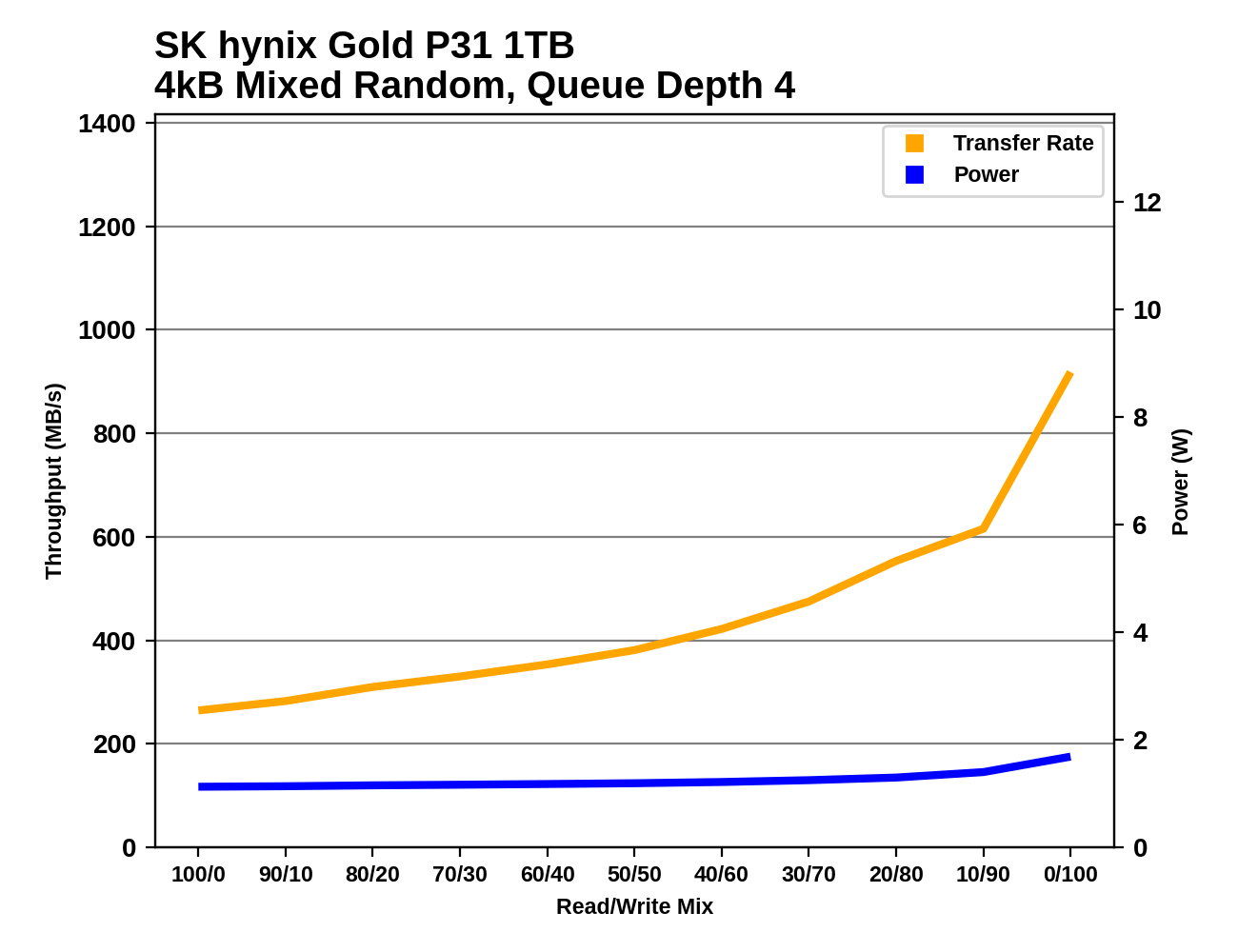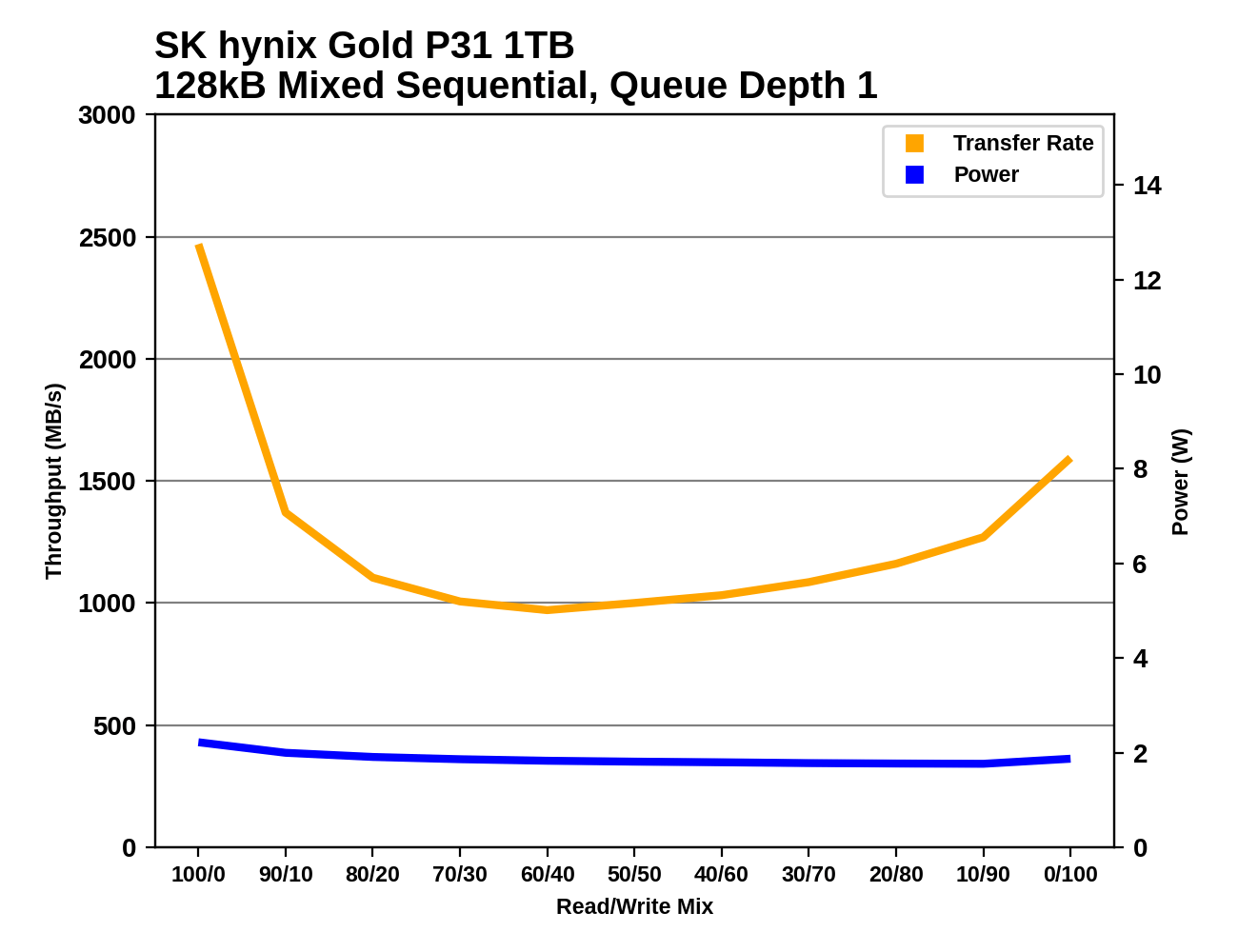The Best NVMe SSD for Laptops and Notebooks: SK hynix Gold P31 1TB SSD Reviewed
by Billy Tallis on August 27, 2020 8:00 AM ESTMixed Random Performance
Our test of mixed random reads and writes covers mixes varying from pure reads to pure writes at 10% increments. Each mix is tested for up to 1 minute or 32GB of data transferred. The test is conducted with a queue depth of 4, and is limited to a 64GB span of the drive. In between each mix, the drive is given idle time of up to one minute so that the overall duty cycle is 50%.

The Intel Optane 905P holds on to a very comfortable performance lead on our mixed random IO test, but the SK hynix Gold P31 raises the bar for TLC-based SSDs by about 10%.
 |
|||||||||
| Power Efficiency in MB/s/W | Average Power in W | ||||||||
The Gold P31 has the lowest average power consumption on this test out of all the drives in this batch, which naturally leads to a massive lead in power efficiency: it delivers twice the performance per Watt of the next best drive.
 |
|||||||||
Compared to other high-end TLC-based SSDs, the Gold P31 performs best during the more read-heavy phases of this test. Several competitors catch up to it and a few surpass it during the most write-intensive portions of the test, but that also tends to be where the P31's power usage advantage is widest.
Mixed Sequential Performance
Our test of mixed sequential reads and writes differs from the mixed random I/O test by performing 128kB sequential accesses rather than 4kB accesses at random locations, and the sequential test is conducted at queue depth 1. The range of mixes tested is the same, and the timing and limits on data transfers are also the same as above.

The mixed sequential read/write performance of the SK hynix Gold P31 is unimpressive. For once, its performance is about what we'd expect from a drive designed more for efficiency than raw performance. However, it still has an 18% lead over the slowest 8-channel drive in this batch.
 |
|||||||||
| Power Efficiency in MB/s/W | Average Power in W | ||||||||
The Gold P31 still completes this test with remarkably low power consumption (averaging less than 2W), but the relatively modest performance means its efficiency score is only about 33% above the next best drive in this bunch.
 |
|||||||||
After starting out with a good sequential read speed, the SK hynix Gold P31's performance drops steeply when writes are added to the mix. It bottoms out just below 1GB/s with a 60% reads mix, and then gradually recovers performance to finish with a fairly typical sequential write speed. Power consumption from the P31 doesn't vary much across the test, and it's only above 2W at the very beginning of the test.










80 Comments
View All Comments
MrCommunistGen - Thursday, August 27, 2020 - link
Truly impressive drive! I'm glad you were able to confirm that the power efficiency numbers held up and weren't the result of some kind of measurement error. When the Platinum P31 comes out I'll probably snag a 2TB model to upgrade my 1TB XG6 in my main ITX rig.Interesting that you mentioned the SN520. I needed a 2242 or 2230 SSD for a project I'm working on and was trying to decide between a BG4 and the SN520. I was able to refer to the previous Anandtech 1TB BG4 review but even then, I'm looking at either a 128GB or 256GB drive as that's what's available 2nd hand on eBay and the 1TB drive's performance isn't going to really represent the smaller drives.
On the other hand I've found exactly nothing on the SN520.
They're cheap enough so I decided to just buy one of each and test them both and see how they compare.
Luminar - Thursday, August 27, 2020 - link
The 2280 form factor SN500s/SN520s are more common than the 2242s and 2230s.I would buy a 2280 SN520 and just Dremel it down to a 2242 form factor. It's been proven to work. As Anandtech wrote in their review, the electronics are only in the first 30mm of the PCB.
MrCommunistGen - Thursday, August 27, 2020 - link
For the heck of it I decided to buy a bunch of different 2230 and 2242 SSDs on eBay to test. I was surprised to find 6 different models, 5 of which are from well-known brands. They all seem to be OEM drives pulled from laptops.I skipped any of the no-name, known garbage drives.
lilkwarrior - Thursday, August 27, 2020 - link
Why was the 970 plus in the benchmarks, but not the 970 Pro?MrCommunistGen - Thursday, August 27, 2020 - link
If you really want to compare the performance of the P31 and the 970 Pro, you can look up the results in the "Bench" section of the website:https://www.anandtech.com/bench/product/2627?vs=24...
To answer your question directly:
I'd imagine that's because for a lot of client workloads the performance of the 970 Pro is relatively similar to the 970 EVO Plus. The Pro definitely has lower latency, particularly write latency -- but again -- in most client workloads that isn't going to translate into very noticeable differences.
However, the Pro is SO much more expensive. Realistically, someone shopping for a fast consumer SSD who is looking at the P31 isn't going to also be considering the 970 Pro.
FWIW, at the 1TB capacity the 970 Pro seems to be selling for ~$320, the 970 EVO Plus for ~$190, and the P31 for $135.
If the idea is to compare to the highest performing non-volatile storage available today, that's probably what the Optane 905P results are for.
PaulHoule - Thursday, August 27, 2020 - link
It is as if Taiyo Yuden started making writable DVD's under its own name.nirolf - Friday, August 28, 2020 - link
Ha ha! Good one!jyotaro - Thursday, August 27, 2020 - link
Any plans for a 500gb review of this product?Billy Tallis - Thursday, August 27, 2020 - link
Not at the moment. I'll try to get them to cough up a sample of that one when the Platinum P31 is released so I can compare across the full range of capacities, but I don't know how likely it is that they'll agree. This is still a pretty new relationship between us and SK hynix PR.ozzuneoj86 - Thursday, August 27, 2020 - link
Maybe I missed it, but does the high efficiency of this drive translate to significantly less heat output? Seems like it should. Some kind of thermal test would be useful for choosing a mobile SSD especially.